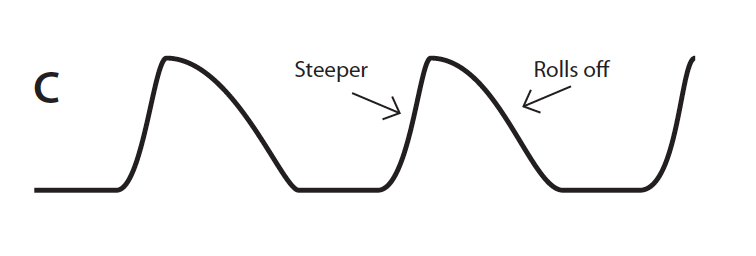After the laryngeal recognition the next thing we wanted to find out was if it was possible to identify the modes by the Laryngograph waveforms alone. It turned out that there are, to some extent, patterns in the waveform that could be used to identify the modes.
When looking at the videos from the endoscopy study in 2007 certain patterns are seen in the waveform within each mode. A still image for each of the modes was produced from the videos.
Each set of five (Neutral without air and Neutral with air were viewed separately) video images and waveforms were analysed by Julian McGlashan and Cathrine Sadolin and the appearance and relationship between the key features were agreed by consensus and documented. The consistent features were identified and schematic drawings produced with descriptive and explanatory text to aid pattern recognition.
The waveform is depicted as a line.

Notice the Curbing laryngograph waveform. It shows a steep onset and a fairly long closure of the vocal folds with a roll off compared to Neutral. The steep onset indicates that the vocal folds are coming together rapidly and the wider shape indicates that the vocal folds stay together for longer (averaging 55.3% in males and 47.5% in females), which corresponds nicely with the louder volume often used in Curbing.
On the stills and videoes the waveform is displayed with a green line in the bottom of the image.
The laryngograph waveforms are more to be seen as patterns of progression from mode to mode, rather than absolutes. The waveforms often differ from singer to singer, some singers have really weird waveforms, but still the patterns often show similar features. The progressive change in the patterns can be used as a guideline on how to identify the modes for an individual singer.
This information comes from a study Visual Vocal Mode Test Study on stills, with the title ‘Laryngeal gestures and Laryngograph data associated with the four vocal modes as described in the Complete Vocal Technique method of singing teaching’. This study was presented by Cathrine Sadolin and Julian McGlashan at BVA ‘Choice for voice’ conference in London, England, 2010.

